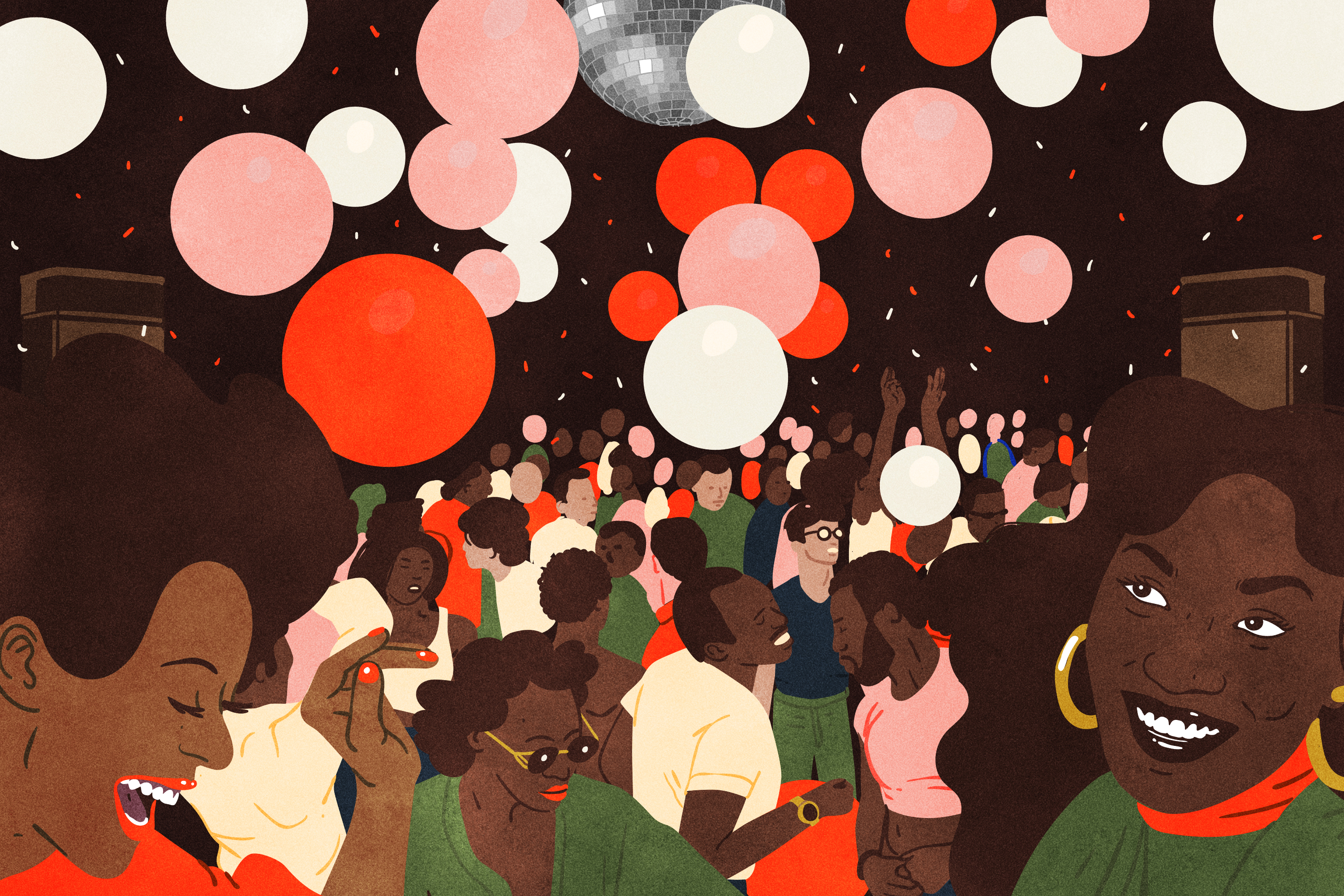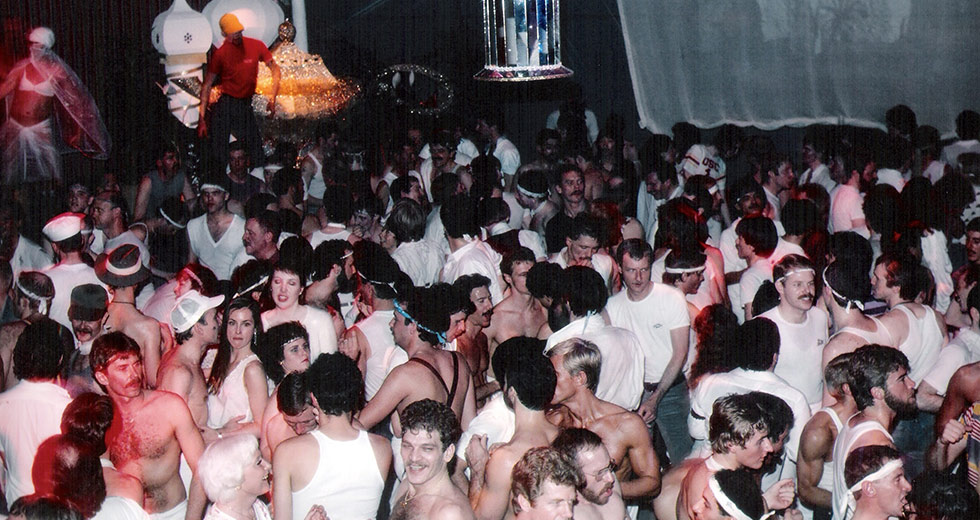Nightclubbing: New York City’s The Saint
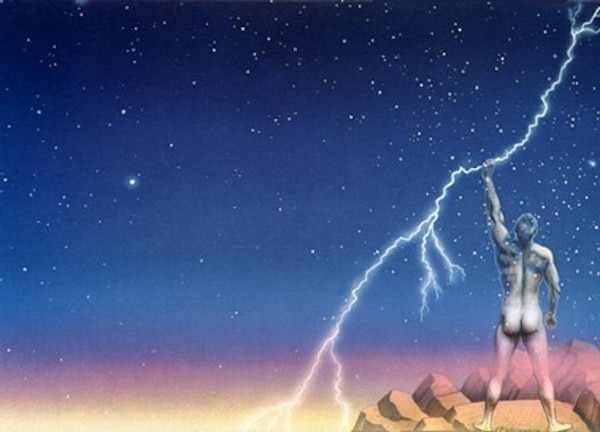
“I always feel terrible when I talk to young guys who have no idea what The Saint was like,” says Susan Tomkin, former assistant to the ultimate gay disco’s principal owner Bruce Mailman. “They go to dance clubs that are just little tiny places. The Saint was so spectacular. I can remember the first time I went upstairs into the dome. The star machine was on, and the lights were going. I felt like somebody had sliced off the top of my head, and poured acid in my brain. That’s the only way I could describe it. It was absolutely like another world.”
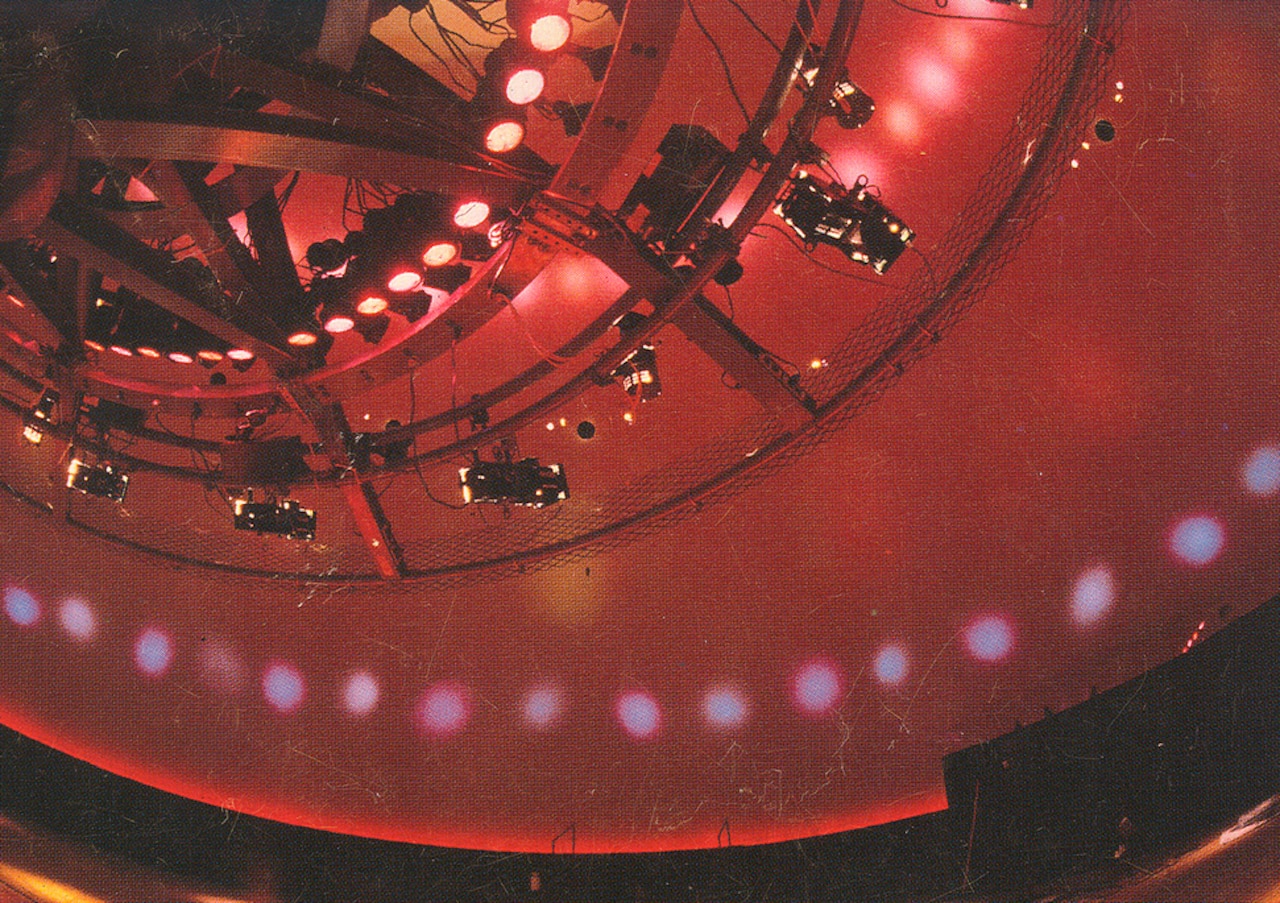
From September 1980 to May 1988, The Saint defined gay nightlife in New York during its most tumultuous and literally plagued decade. Conceived by off-Broadway impresario Mailman, who had just scored a runaway success with The New St. Marks Baths, The Saint set such high standards that it soon rendered its competition redundant.
“When it opened, it just sucked the life out of all the other clubs,” says Robbie Leslie, the most popular of the disco’s surviving DJs. “Everyone abandoned these clubs they professed loyalty to. It only took a week or two, and they just flocked over to The Saint.”
All this splendor ultimately cost $4.6 million in 1980 dollars – well over $13 million in today’s currency.
Housed in the three-story former site of the psychedelic rock concert hall Fillmore East, The Saint offered multi-sensory pleasure like no other venue before or since. It featured a circular, 4,800 square foot dancefloor topped by an aluminum dome 76 ft. by 38 ft. under which much of the club’s 1,500 lights would shine, as well as constellations from a Spitz Space System projector ten times brighter than one in a typical planetarium. Designed by architect Charles Terrell, The Saint pointedly directed one’s attention skyward. Its experience was clearly meant to be uplifting – visually and otherwise.
The perforated dome hid the last and largest of the revered Graebar sound systems: Powered by 630 drivers and 32 amplifiers, nearly 500 speakers generated 26,000 watts – a figure touted in The Saint’s publicity materials as being “probably the most powerful per square foot for entertainment purposes in existence.” All this splendor ultimately cost $4.6 million in 1980 dollars – well over $13 million in today’s currency.
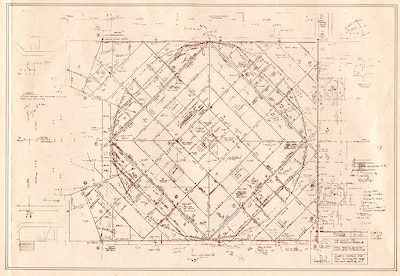
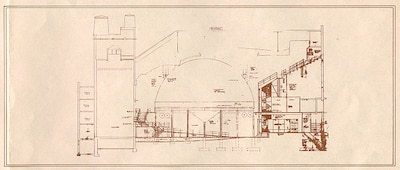
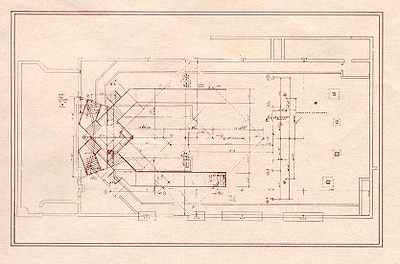
The circular dancefloor meant no corners to hide in, no hierarchy, nothing more prominent than anything else. That’s not to say The Saint wasn’t elitist: For its first five years, The Saint was a members-only club that meticulously chose and guarded its clientele. Before the club opened, invitations were sent to Fire Island Pines homes owned by A-list gays who typically danced at Flamingo, The Saint’s similarly exclusive Manhattan predecessor. Membership for them started at $125, then rose to $150 yearly.
Soon after an open house for investors spread word of the venue’s fabulousness, membership closed and a waiting list began, even before the club opened. Membership then was set at $300. The Saturday entrance fee was $12 for members and $20 for their guests; both figures were higher for special events like the famously uninhibited annual Black Party. One had to be recommended by two members just to be eligible for membership; many were turned down.
In the earliest ’80s, it was hip in NYC to be homo, and Saint dancers ranked among Manhattan’s handsomest, most talented and well-connected.
For most of its run, only the club’s very few female members could bring women guests on Saturdays: On a typical Saturday night of 4,000 to 5,000 during the club’s early years, there’d be no more then a dozen women, and they were expected to dress like the guys – absolutely no high heels that could get stuck in the industrial metal stairways. Saint management contracted non-Caucasian talent like Latino DJs George Cadenas and Richie Rivera; black lesbian DJ Sharon White; black lighting man Richard Tucker and Japanese-American DJ Nao Nakamura. But almost everyone who partied at The Saint was white – a fact inescapable when revelers shed shirts in the disco heat.
But those it did welcome were united to a degree nearly unimaginable today. This was the final and most extreme iteration of the “clone” era, when gay men made themselves identifiable to each other by a code of masculine presentation – close-cropped hair, trim mustaches, tight T-shirts, faded Levi’s 501s, leather vests or harnesses. When Mailman’s St. Marks Baths brought clones flocking to the East Village, some of the neighborhood’s radical queers weren’t happy. The book Fire in the Belly: The Life and Times of David Wojnarowicz relates a story about future art superstar Keith Haring stenciling “Clones Go Home” on sidewalks leading from the West Side where clones congregated, and signing the warning “FAFH” for the imaginary group Fags Against Facial Hair. While East Village punks and New Romantic dandies flaunted their inner freak, Saint clones conformed, and their knack for precision extended to their drugs. The gay club cognoscenti knew what to take and when to take it, and the night’s music both reflected and reinforced their collective trips.
These synchronized tribal rites were created by the first openly gay generation in one of the few cities in which they were possible. Its arbiters worked in the fashion industry, the arts or a myriad of businesses that addressed their needs via bars, restaurants, barbershops, haberdashers, bookstores and bathhouses. There, among their kind, it was safe to come out. Beyond those haunts, it often wasn’t. Soon Saint membership swelled with attorneys, architects, investors and other closeted professionals. In the earliest ’80s, it was hip in NYC to be homo, and Saint dancers ranked among Manhattan’s handsomest, most talented and well-connected. Their confidence radiated through a community still in need of positive reinforcement: The bigotry of Anita Bryant and the assassination of Harvey Milk were recent memories. Same-sex intimacy had actually been illegal in New York State until 1980.
“For those of us who constructed gay culture in the 1970s, there was no blueprint or manual,” explains Felice Picano, one of the decade’s most enduring gay writers. “I went to all the gay discos that preceded, like The Tenth Floor, The Loft, Paradise Garage, 12 West. Flamingo was my club; the same people I knew in Manhattan and slept with at Fire Island were there, and so I was there opening night at The Saint. It was very big, very crowded; the coat check people were overwhelmed, the bar people were overwhelmed. I don’t think we went back until the holidays because it seemed like it was not completely ready.”
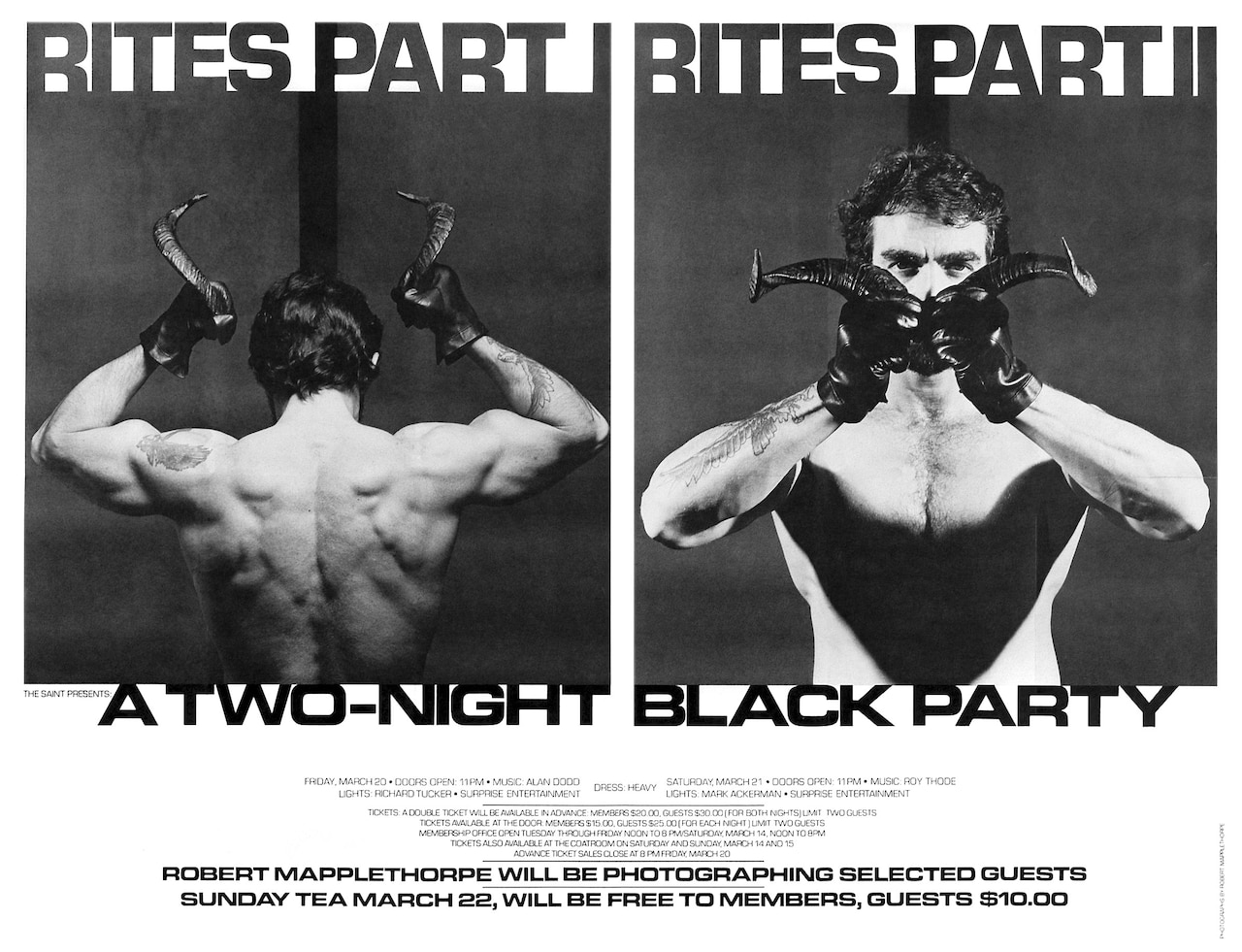
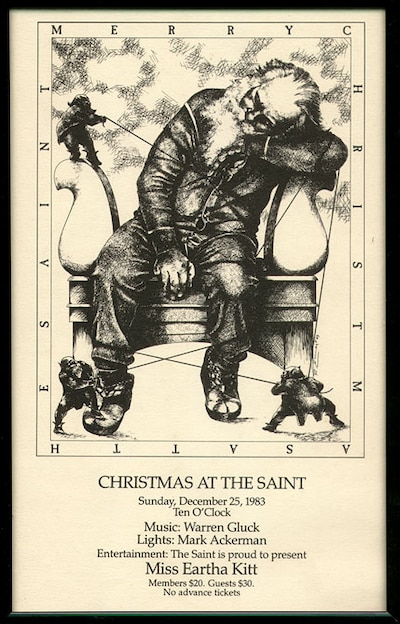
By then, the club more than proved its professionalism: Members were kept abreast of special parties by elaborate announcements on posters featuring the work of acclaimed photographers and artists like Robert Mapplethorpe and Richard Elmer; for these theme events, the club was decked out in one-night-only décor, like 3,500 square feet of Astroturf for the first season’s Thanksgiving event. True to Mailman’s thespian roots, The Saint was thoroughly immersive, multimedia art – disco Gesamtkunstwerk.
Unusual for a club of its magnitude, The Saint was seasonal: Since much of its clientele vacationed on Fire Island, The Saint opened after Labor Day and closed mid-June until 1985. At first, it was only open two nights a week, Saturday and Sunday, plus an occasional seasonal party. In the second year, there were a few Wednesday “New Talent Night”s. The Saint rarely opened on Fridays until its last two years, when that night accommodated straights all year round.
This elaborate scheduling might seem puzzling unless you knew what a Saturday at The Saint was like. On those nights, the club usually opened at 11 PM, when the DJ would warm up the system with an hour of classical music, slow synth sounds, or ballads. Then the spinner would segue into light, leisurely paced club music.
As the night progressed, the tempo and intensity increased by tiny, nearly imperceptible increments until climaxing around 6 AM, when the DJ would stop the music and the still-sizeable crowd would applaud as if giving a Broadway cast their standing ovation.
Then the DJ would resume, but at a somewhat slower tempo, and in a more lyrical and romantic style known as “morning music.” In a morning music set, the tempo of the tracks might build again, but typically not their intensity. Instead, DJs programed morning sets to ease dancers off stimulants and take them down an ethereal, more relaxing and soulful path for several more hours. Then the jock would usually take another encore, henceforth playing what many call “sleaze.” Sleaze might be overtly sexual, like Skatt Bros.’ “Walk the Night,” but usually not; its foundation was openhearted R&B; songs of longing, or regret, or sorrow or unmitigated joy.
This misnomer – Leslie emphatically objects to it – was especially deceptive because quintessential “sleaze” selections like Sharon Ridley’s “Changin’” or Viola Wills’ “Somebody’s Eyes” ranked among the evening’s most sensitively arranged tracks. Even when club music lost much of its compositional sophistication as the decade progressed, a “sleaze” set always radiated class.
The Saint’s initial core DJs – Alan Dodd, Jim Burgess and Roy Thode – all excelled at both building excitement and releasing it. Although overlooked by many club historians, Dodd played on The Saint’s opening night, September 20, 1980. As with Leslie, Dodd was a 12 West resident before his Saint engagement. That alone meant his skills were enviable.
“Alan Dodd was the most humongous influence on me because of the delicate way he put songs together,” Leslie recalls. “I always liked him best because his style was very smooth, not jarring at all. He straddled the styles of oldies and current music – what was already fluffy, and music that was slightly hard-edged – and put it all together so beautifully. He also had a calm demeanor in the DJ booth I always admired. In fact, I tried to copy that.” But after The Saint’s first season, Dodd retired from DJing entirely.
Years before it became de rigueur to beef up pop beats for the dancefloor, Jim Burgess pioneered the practice.
Unlike Dodd, Burgess boasted a larger-than-life personality and résumé. During disco’s commercial apogee, his remixing credits graced many gay favorites like Madleen Kane’s “Rough Diamond” and “Forbidden Love,” as well as rock crossovers like Rod Stewart’s “Do Ya Think I’m Sexy?” and The Doobie Brothers’ “What a Fool Believes.” Years before it became de rigueur to beef up pop beats for the dancefloor, Burgess pioneered the practice.
“He was such a presence that people were a bit intimidated and in awe of him,” Leslie remembers. “That was his mystique.”
Burgess’s flair for drama extended to his mixing. A trained opera tenor, he peppered his sets with classical music interludes, and sequenced them in the manner of a symphony with andante and largo movements. He also dropped in dialog snippets from vintage films beloved of gay viewers, like the 1942 Bette Davis vehicle Now, Voyager, which contained the oft-quoted line, “Don’t let’s ask for the moon; we have the stars” – an apt one for a planetarium disco.
“Of all the DJs, he was the one who would try things and present them in such a way where you would love it,” recalls another 12 West vet Richard Tucker, The Saint’s sole surviving lighting man. “He had such a great sense of presentation. His downtempo set, no one can touch it.” Featuring pre-stardom Luther Vandross, Burgess’s remix of Bionic Boogie’s “Hot Butterfly” remains a morning music staple. So are his treatments of Nicolette Larson and Alton McClain & Destiny.
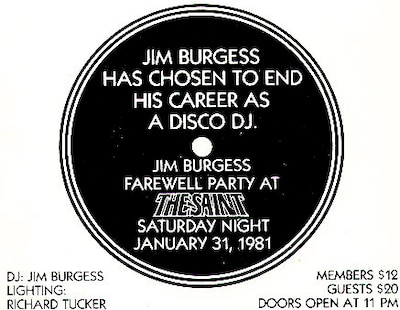
But halfway through The Saint’s first season, Burgess also gave up DJing: He wanted to pursue an opera career. Before retiring, he played his farewell party, where he secretly staged an exit long remembered. As Sharon White recalled to RBMA in 2013, Burgess closed his set with the dancefloor still packed. As the crowd cheered the tux-clad jock, he strolled to the door, leaving Tucker, White and others scrambling to find records that might sooth baffled dancers.
Thanks to years of blowing people’s minds at The Ice Palace, Thode had long been a legend on Fire Island. What he did at The Saint confirmed his ability to take dancers on a profoundly emotional ride: Listen how he dramatically shifts gears to play mega-hits “I Will Survive” and “Stayin’ Alive” back-to-back during his New Year’s Eve 1981/1982 set. Like a rocker who struggles to affirm life right before his demise, that blend boasts even more resonance in retrospect. Just a few months later, in May 1982, The Saint lost another DJ, this time to what was deemed a suicide by some close friends like White, and an accidental overdose by others.
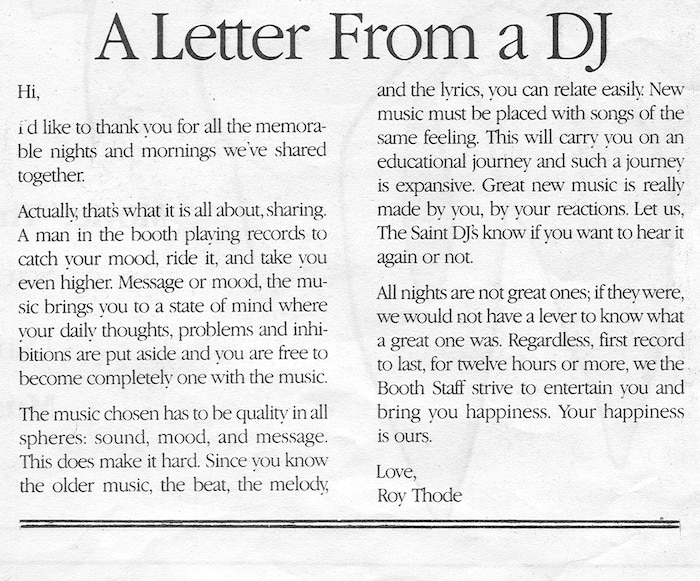
“I did not see that coming,” Leslie admits. “For a tall guy who looked kind of menacing – he wore leather vests, and all that stuff – he was a sensitive man, and was prone to periods of melancholy. He was a loving soul, and that showed in his music. If somebody came up to him and said ‘You suck,’ that would ruin the rest of his night. That’s how sensitive he was. It’s one of the reasons why he was so good – because he cared so much about what he did.”
“Roy was very insecure,” recalls Warren Gluck, who started at The Saint in November 1982. “I remember him saying to me, ‘Warren, they always want me to be perfect and I just don’t know if I can do that,’ which was sad because he was so fantastic.”
According to Leslie, whose first Saint gig was Christmas Day 1980, Mailman had intended to book his club with out-of-town DJs – a common practice now, unheard-of then. As management endeavored to replace its original roster, it became clear that members wouldn’t welcome just any hyped jock, and certainly not those unaccustomed to playing for them.
“A lot of it has to do with where they’d partied prior to The Saint,” Leslie recalls. “They’d been dancing at The Sanctuary, The Tenth Floor, Flamingo and 12 West, and of course Fire Island – the Blue Whale, which was tea dance, The Sandpiper, and The Ice Palace. Put those all together and you’ve got a very specific sound. Gay men in New York were the arbiters of disco, right from the get-go. By 1980, they knew what they liked, and their taste was rigid. It took a lot to get them to try things they weren’t prepared to accept.”
I was thinking, “My god, he’s playing in the most spectacular club in the world, and has no musical sense whatsoever.”
So when Mailman replaced Dodd, Burgess, and Thode with a core of eight regular DJs, he once again chose DJs already hot with the crowd. As time went on, The Saint featured nearly every jock who’d already wowed them: Among them were Leslie, White, Gluck, Chuck Parsons, Wayne Scott, Howard Merritt, Casey Jones, Terry Sherman and Michael Fierman. Very few broke in without years of experience.
“There was one DJ, Sean Buchanan, who had a short but meteoric career,” Fierman recalls. “He was gorgeous, and people were into that. I can’t blame them; you look up, and there’s Paul Newman in the booth. He played very, very, very pretty stuff, but man, I have to tell you, this guy could not mix. Once I went to his apartment and said, ‘Your mixes, they don’t make any sense.’ So we started talking, and he didn’t even understand the downbeat, the measures – one, two, three, four. I was thinking, ‘My god, he’s playing in the most spectacular club in the world, and has no musical sense whatsoever.’”
Buchanan started at The Saint in 1983 and played throughout much of 1984, including that year’s Land of Make Believe and New Year’s Eve parties. In February ‘85, he hosted his own goodbye soiree before heading back home to England: Buchanan was the first Saint DJ to die of AIDS. He would not be the last.
In 1981, The New York Times reported that dozens of gay men had been mysteriously falling ill from Kaposi’s Sarcoma and other opportunistic infections; this outbreak was tagged “gay cancer.” Steve Casko – The Saint’s project manager, who oversaw the building of both the club and St. Marks Baths – remembers that what in 1982 was called GRID (gay-related immune deficiency) and later that year AIDS was first nicknamed “Saint disease” by some because so many who came down with it had danced there.
I was actually convinced that you could get AIDS from drinking at the water fountain at The Saint.
“I was actually convinced that you could get it from drinking at the water fountain at The Saint,” remembers Andrew Holleran, whose 1978 novel Dancer from the Dance fictionalized his own immersion in underground gay clubs like The Tenth Floor and The Loft. “I was sweaty on the dancefloor and I’d brush against somebody who was also sweaty and I used to think that might give me AIDS. That’s how cuckoo it was.”
Soon panic turned to shellshock, and by the end of The Saint’s third season, the disease started claiming significant and exponentially larger portions of the club’s clientele. Still-hearty dancers returned less often: Many devoted themselves to nursing gravely ill comrades.
“All these new friends I’d made were dying in front of me,” recalls Mailman’s assistant Susan Tomkin. “It got to a point where if someone came to see me at the office, and the girl from the front desk called to say, ‘So and so is here,’ I was terrified to see what was going through the door because I never knew what condition somebody was in. People were getting sick so quickly.
“Bruce used to get annoyed with me. If somebody called and said, ‘So-and-so is in the hospital with pneumonia,’ I knew what that meant. And Bruce would say, ‘Why do you think right away that they’re really sick?’ And I’d sit with him and say, ‘Because I’m living in the real world.’”
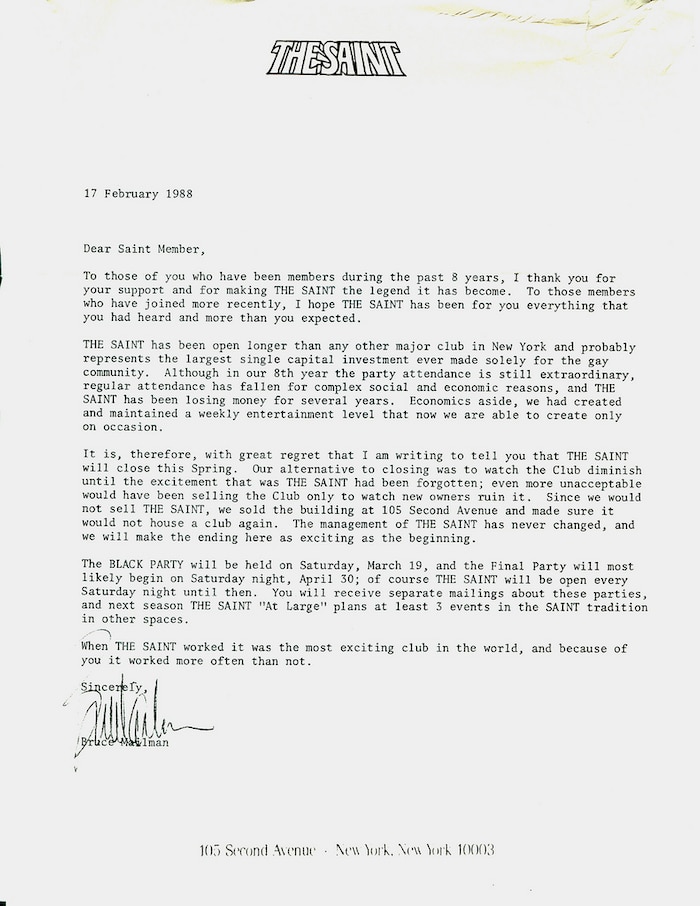
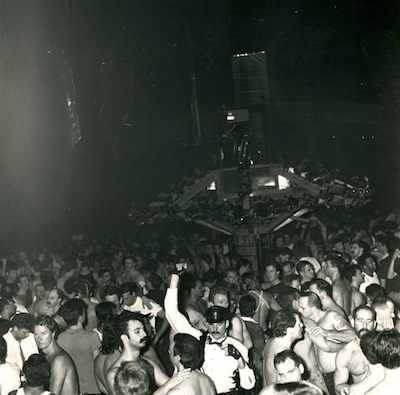
For Saint employees, the party still went on, plague or no plague. “It was challenging,” Gluck admits. “My lover died from AIDS back then. It was something you had to think about, but people came to that club to forget about their daily lives, and so I left my thoughts at the door.”
As time went on, the club that initially kept many out struggled to bring people in: Increasing numbers of party invites were returned by the post office; people had died, or moved away to die. The once-packed dancefloor thinned out considerably. Formerly the site of unbridled sexual activity, the balcony beyond the dome became patrolled: Staff did their best to interrupt anything besides necking and hand jobs. The performers in Black Party sex acts started using protection. These changes weren’t always welcomed. Toward the end, the only nights that brought crowds that compared with a regular Saturday in the first few years were the special events.
To accommodate these changes, The Saint began the lengthy, complicated process of obtaining a liquor license in 1985. It was deemed necessary to accommodate the straight crowd on Friday nights. Gay men were content to swig from hidden stashes because that had long been their practice at members-only clubs predating The Saint.
If I stood in that DJ booth on a Saturday night and watched 2,500 gay men dancing, I swear you could’ve sent a spaceship to the moon with that energy.
But that’s not how straights partied in the ’80s. To bring the building up to liquor-selling code, additional entrances had to be built: According to Casko, the venue’s Certificate of Occupancy was not as a nightclub, but as a theater offering “audience participatory dancing.”
“Once the straight world came into The Saint, it was never the same,” claims Tomkin. “It was just not made for them. There were women who were friendly with gay men and knew how to conduct themselves, but Bruce tried very hard not to have the club be overflowing with them. It sounds terrible for me to say this, [but when] you’d get some straight woman from Long Island who didn’t have any idea what she was surrounded by, and she’s all dressed up in jewelry and high heels, it just didn’t work. If I stood in that DJ booth on a Saturday night and watched 2,500 gay men dancing, I swear you could’ve sent a spaceship to the moon with that energy. The energy level just wasn’t the same when it was straight people.”11Tomkin, it should be noted, is heterosexual and a proper businesswoman; she’d never been to a disco of any sort until she started working for Mailman in November 1980.
“It was the most bizarre thing to see people wearing shirts and sweaters while dancing,” says Gluck, “and the girls dancing with their pocketbooks in a circle, badgering me for stupid old disco requests. I did it once: That was that.”
“When we were building The Saint,” Casko recalls, “I’d talk to people on the block. I’d tell them it was going to be a gay disco, and they were up in arms. Then it opened. The members would line up single file, and when they went in, the sidewalk was cleaner than when they arrived. When the straight nights happened, there were fights in the lines, broken bottles. Then the neighbors would say to me, ‘Why’d you ever let straight people in here?’” 22Casko is also heterosexual.
In 1986, women-only events were also launched, first on Sundays, then on Saturdays; they ended early in the evening before the guys came in. “Mailman never wanted lesbians in there to begin with,” Casko blurts. “But it turns out they drink like four times as much as the guys.” Nevertheless, these nights failed to reverse the general attrition. Leslie had already left the club in November 1986, and in February 1988, Fierman played the last White Party. Days later, Mailman sent members a letter that announced the club’s imminent closing. Some DJs bid adieu in their own way: On his final regular Saint gig, Fierman only played personal favorites. On Gluck’s last full night, he structured his set to tell the story of a relationship – meeting someone, falling in love, fighting and falling out of love.
For The Saint’s concluding extravaganza, which started Saturday April 30 and concluded Monday May 2 at noon, Mailman assembled a mega-bill featuring many of The Saint’s most popular DJs – including Fierman, Gluck, Chuck Parsons, Terry Sherman, Howard Merritt and Mark Thomas, as well as Burgess and Leslie, the final two. Together, they and seven live acts played 40 hours of continuous music.
“I was in an office changing from street clothes to black tie, and then it hit me,” Leslie recalls. “I started to hyperventilate. Jim Burgess [who’d returned to DJing before dying in 1993] was running a little overtime, as he was prone. I was like, ‘Okay, I only get four hours – can I please start?’ I wanted to make sure I got in all the songs that were important in those last few hours. It was like a family of about 3,000 on the dancefloor. People wept. It was what they needed to say goodbye to the club and to the people they’d lost.”
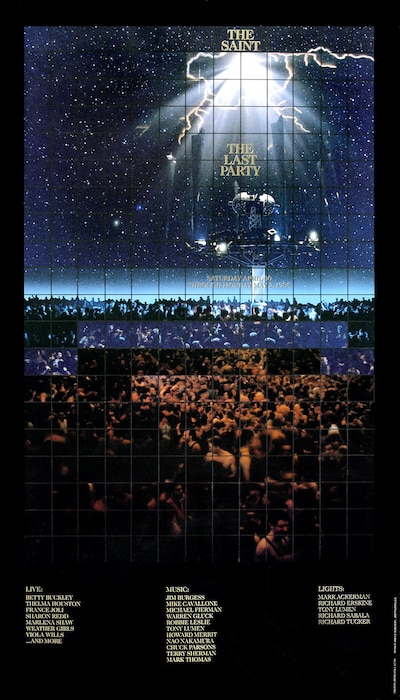
As he remembers that momentous night, Leslie himself starts sobbing. “I’m very fortunate, as that honor was given to me, and I was trusted to close it down. Part of the beauty of it is that people can’t quite grasp it unless they saw it with their own eyes. There were so many different things that contributed to the whole effect – the people, the joy, the heat in the building, the amazing sound system, the lights, the songs. It was the closest to something supernatural and magical that I’ve ever seen in brick and mortar.”
After this sentimental ending, Mailman produced special events as The Saint At Large. These started at various venues, then – for a little over a year – at his former club, which was renamed after its address, 105 Second Avenue, now without its dome and star projector. He continued hosting Saint At Large parties in sizeable Manhattan clubs like Roseland and Roxy until he died in June 1994. Tomkin and Casko, who’d helped helm the parties all along, continued throwing them until Mailman’s cousin Stephen Pevner took over. These parties continued to be frequent, but in recent years have mostly been restricted to one or two events, including The Black Party, which this year moved to Brooklyn. The ritual remains, but the music has changed.
Unlike Northern Soul, ‘70s disco, ‘80s boogie, hip-hop, electro, Italo, house, or Detroit techno, most Saint music has only begun to be revived by current DJ crews, like London’s Horse Meat Disco and San Francisco’s Honey Soundsystem and Go BANG!
Its detractors dismiss it as throwaway hi-NRG, sometimes for good reason: From 1983 until it closed, Saint DJs padded their playlists with formulaic high BPM tracks from prolific producers like Bobby Orlando and Ian Levine: For every turbocharged winner like Claudja Barry’s “Work Me Over” and Evelyn Thomas’s “High Energy,” Orlando, Levine, and their imitators pumped out countless soundalikes; most Saint DJs played them to satisfy their crowd’s need for speed.
Although they were rarely mainstream, Saint hits were played by every Saint DJ; only the club’s discerning dancers could detect substantial differences between jocks, and critique they did: The big parties in particular inspired members to write Mailman letters of praise and outrage inspired by the venue’s latest musical selections, bartenders, decorations, and snacks. Mailman, Tomkin, and Teitelbaum answered every one.
What even their harshest critics can’t take away from them is their ability to mix: As the many Saint sets that circulate among collectors attest, the best Saint DJs were unbeatable in that regard. Several were among the first to mix in key; the first to phase two copies of the same record, or play one two beats behind the other; the first to play records pressed at 45 RPM at 33; the first to maintain a mix for several minutes.
Whereas other ’80s jocks emphasized their eclecticism by slamming from a funk groove to a rock track, Saint DJs typically maximized mood by minimizing distinctions between disco, pop, rock, and soul while smoothly mixing tempo-fluctuating records as if they were all digitally precise EDM. And they did so for 10, 12, 13 hours at a stretch, resting only during the club’s brief live performances: Before management decided Saturday nights could last no longer than Sunday noon, the first Saint DJs often played even longer.
To fill a marathon set for a congregation in the thousands, Saint DJs had to be both crowd-pleasing and resourceful. “I started back when a lot of DJs would only play the stuff that came out that month – that was it,” Leslie asserts. “I thought I could make a better show by marrying different disco eras.” While most clubs pumped the latest hits until closing, which in much of America was 2 AM, Saint DJs followed Leslie’s lead to pepper the entire night with perennials the way they always had in the morning. Lesser tracks came and went with the seasons, but Saint favorites lingered for years. While the evening’s average tempo increased, so did stylistic diversity.
“When I started at The Saint, I was playing an extended version of the 12 West sound I was known for,” Leslie explains. “As the decade marched forward, a lot of what we incorporated into the traditional sound was English dance rock – The Associates, Spandau Ballet, The Lotus Eaters.”
“I was the first to play The Lotus Eaters’ ‘You Don’t Need Someone New’ at The Saint,” Fierman boasts. “I was record shopping in San Francisco around New Year’s Eve ‘83 when it came in. I couldn’t wait to play it.” Full of chiming guitars like The Smiths but with a bigger beat, this unlikely outlier ignored by straight rock clubs grew into a Saint classic long after it disappeared from shops.33“Neither myself nor Peter Coyle, who wrote the song with me, have ever heard of The Saint, nor did we perform in the US,” confesses former Lotus Eater Jem Kelly. “We had a huge hit in the UK and Europe with ‘The First Picture of You,’ but ‘You Don’t Need Someone New’ was released three months later and the lyrics were perhaps too melancholy for the UK. I am, therefore, so happy that it was a success and had its own life beyond its home market.”
The love Saint DJs poured into uncovering and popularizing cult favorites like this one also went the other way. Although ’80s radio phased out most veteran divas that weren’t Diana Ross, Patti LaBelle or The Pointer Sisters, The Saint, despite the whiteness of its crowd, supported black female vocalists who appeared there when most acts of any sort wouldn’t acknowledge gay fans.
The Saint’s bond with African-American songbirds was profound. Although their performances were generally limited to 15 minutes of singing to tape, these gigs – sometimes years after their records left the charts – helped sustain talents often otherwise neglected. The divas showcased there sang of struggling to triumph while facing cataclysmic adversity; a situation gay men in the ’80s knew all too well.
It’s only right that Linda Clifford – a former Miss New York State nurtured by R&B kingpin Curtis Mayfield – gets the last word: Leslie remembers Clifford’s performance in the spring of 1982 at the height of “gay cancer” panic as among the club’s most memorable.
“When I walked in, I thought, ‘Wow, this place is freakin’ huge,’” Clifford recalls, “and immediately ran to a dressing area, so I didn’t get to see the crowd until I hit the stage. Holy shit! It was one of those things that takes your breath away and then you’re like, ‘Snap out of it – you’ve got a job to do.’ I sang ‘Runaway Love’ and incorporated some of the guys in the audience into my whole shtick, and they went insane. Just insane. And I thought to myself, ‘I’m in heaven.’ On the ceiling, it looked like stars. Maybe that’s why I relate this whole thing to being in heaven.
“Then I thanked them for making my dreams come true because that’s what they did. I sang ‘If My Friends Could See Me Now’ and – I’m not kidding you – for 20 minutes after that, they screamed and ranted. It was like ‘You can play another song, but we’re not dancing to it.’ I was like, ‘Oh my God, I gotta go back.’ And the management was like, ‘No, you’re contracted for two songs – that’s it.’ Now, I had performed at Studio 54 and that’s pretty big and decadent, but it was not on the same level. The Saint audience was without a doubt the craziest and most fun group I’ve ever played for. They just went nuts, and made me go nuts.”
Red Bull Music Academy was a proud supporter of Tim Lawrence during the writing of his book Life And Death On The New York Dance Floor, 1980-83. To learn more about this fertile time in New York nightlife, check out the series of YouTube playlists taken from his book celebrating the scene. Embedded below is a playlist from Alan Dodd from their first night at The Saint.
Header image © The Tim Smith Collection about The Saint at the Fales Library / NYU
